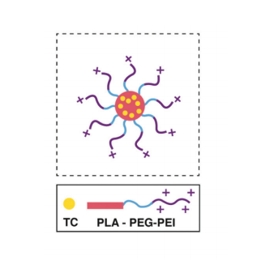文献:Development of polycationic micelles as an efficient delivery system of antibiotics for overcoming the biological barriers to reverse multidrug resistance in Escherichia coli
文献链接:
https://pubmed.ncbi.nlm.nih.gov/32412567/作者:Rong Guo,Keke Li, Jing Qin, Shengli Niu and Wei Hong
相关产品:PLA (5K)-PEG (2K)-PEI (2K)(聚乳酸-聚乙二醇-聚乙烯亚胺)
PLA (5K)-mPEG (4K)(聚乳酸-甲氧基聚乙二醇)
原文摘要:
Highly pathogenic Gram-negative bacteria (G−) are tenacious and pose a serious threat to public health,mainly because of three biological barriers: cell envelope blockages, biofilm protection, and macrophages shelter. One strategy to bypass the biological barriers and consequently achieve a satisfying G− bactericidal effect is to utilize polymeric micelles with superior bacterial recognition and binding capabilities. In the current study, we explored the biological barriers penetration ability of a traditional polycationic micellar system (PP-PEI) based on a copolymer of polylactide-poly (ethylene glycol)-polyethylenimine (PLA5K-PEG2K-PEI2K). Subsequently, tetracycline (TC) with good fluorescence property was encapsulated into the PLA core of the micelle (PP-PEI/TC) through hydrophobic interaction. The combination of a PEI shell and loaded antibiotic drug endowed the polycationic micelles with a greater capacity for killing drug-resistant bacteria, destructing biofilms, and eradicating intracellular bacteria, compared with free TC and micelles without the inoculation of a PEI moiety. Confocal laser scanning microscopy (CLSM) and flow cytometry illustrated that PP-PEI/TC could completely penetrate and accumulate in drug-resistant E. coli, biofilms, and infected macrophages. The efficient biological barrier penetration was elucidated as due to the strong electrostatic interactions between the polycationic PEI block and the anionic composition of the bacterial outer membrane (e.g., LPS), macrophage cell membrane (e.g., phospholipid), and extracellular polymeric substances (e.g., eDNA), which was confirmed by biolayer interferometry (BLI).
Once the micellar system was bound to a negatively-charged surface, bacterial and cellular enzymes could degrade the PP-PEI core to release its antibacterial content and finally kill planktonic bacteria, bacteria over the depth of a biofilm, and/or intracellular bacteria. In vivo imaging indicated that fluorescent polycationic micelles accumulated in bacterial infection sites with strong fluorescence. In vivo antibacterial experiments showed that PP-PEI/TC could dramatically reduce the number of drug-resistant E. coli EB1-1 in the peritoneal cavity of acute peritonitis BALB/c mice compared with its counterparts. In conclusion, our study demonstrated that polycationic micelles with a PEI shell could penetrate into drugresistant bacteria, the biofilm matrix, and infected macrophages and lead to the spatiotemporal release of antibacterial agents for the comprehensive treatment of drug-resistant relevant infections.
PLA (5K)-PEG (2K)-PEI (2K):PLA 聚乳酸,一种生物可降解的热塑性聚酯。在这个化合物中,PLA 的分子量为 5000。聚乳酸具有良好的生物相容性和机械性能,被应用于生物医学领域,如组织工程支架、化合物缓释载体等。PEG(聚乙二醇)PEG 的分子量为 2000。它是一种亲水性的聚合物,具有良好的水溶性、生物相容性和低poison性。在化合物递送系统中,PEG 可以用来增加化合物的稳定性、延长化合物在体内的循环时间,并且可以减少蛋白质和细胞的非特异性吸附。PEI(聚乙烯亚胺)这里 PEI 的分子量为 2000。PEI 是一种阳离子聚合物,具有较高的正电荷密度。它能够与带负电荷的生物分子(如 DNA、RNA 等)通过静电作用结合,在基因转染等过程中发挥作用。
PLA (5K)-mPEG (4K):PLA 分子量为 5000,它是一种具有良好生物可降解性和生物相容性的聚酯。其合成通常是通过乳酸单体的缩聚反应或者开环聚合反应得到。聚乳酸的机械性能和热稳定性使得它在包装材料、组织工程等多个领域有应用。mPEG(甲氧基聚乙二醇)分子量为 4000(4K),它是聚乙二醇(PEG)的一种衍生物。mPEG 的一端是甲氧基(-OCH₃),另一端是羟基(-OH)。甲氧基的存在使得 mPEG 在化学反应中有一定的选择性,并且增加了其在有机溶剂中的溶解性。PEG 本身具有良好的亲水性、生物相容性和低poison性,用于化合物递送、生物材料表面修饰等领域。基于PLA (5K)-PEG (2K)-PEI (2K)、PLA (5K)-mPEG (4K)的性能,PP-PEI/TC的合成如下:

图:组装示意
在甲醇中制备TC和PLA-PEG-PEI的溶液,并进行超声处理。在一定温度下旋转蒸发去除溶剂,得到薄膜,在室温下进一步蒸发,去除膜中的甲醇残留物。将薄膜置于 PBS中,过滤去除TC聚集体,制备胶束溶液。采用类似的方法对mPP/TC胶束进行了制备,在mPP/TC胶束期间使用PLA-mPEG代替PLA-PEG-PEI。

图:电镜图像
结论:
该文献成功制备出基于PLA (5K)-PEG (2K)-PEI (2K)、PLA (5K)-mPEG (4K)合成的PP-PEI/TC。实验表明,具有PEI壳的聚阳离子胶束可以穿透耐药bacteria、生物膜基质和被感染的巨噬细胞,并导致抗菌化合物的时空释放。

 2025-02-14 作者:ws 来源:
2025-02-14 作者:ws 来源:

